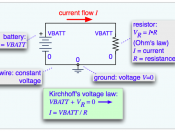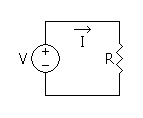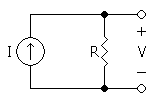Objective: The purpose of this lab is for student's to investigate the relationship between the three variables involved in Ohm's Law- Current, Voltage, and Resistance.
Theory: The Ohm's law states that the direct current flowing in a conductor is directly proportional to the potential difference between its ends. It is usually formulated as V = IR, where V is the potential difference, or voltage, I is the current, and R is the resistance of the conductor.
Formulas:
V=IR
Materials:
1) Circuits Experiment Board
2) D-Cell
3) Wire
4) Digital Multimeter (DMM)
5) Resistors
Diagrams:
Ammmeter
Umm Wire
Volt Meter
rheostat
Procedure:
1) Making sure that the switch is open carefully construct the circuit. When connecting the current meter ( 50ma Full-Scale meter) in series with the resistor R make sure that the + terminal and the - terminal are connected properly. Otherwise, the pointer of the current meter will deflect in the wrong direction when current passes through the circuit and this could very well damage the meter itself.
2) Connect points A and B of the circuit to the red and black terminals (0-12 VDC) of the power supply. Make sure that the rotating knob of the power supply is turned down to zero (fully clockwise). Adjust the decade resistance box to 100 ohms.
3) By carefully turning the power supply clockwise with the switch closed measure the voltage across the resistor R when the current is adjusted from 5ma to 50ma in increments of 5ma*.
B. Variation of currents with resistance keeping Vr constant.
1) Repeat steps 1 and 2 of part A above.
2) For each value of R in table II very carefully adjust the knob of the power supply until the voltage across the resistor R is 10 VDC and measure the current for...


